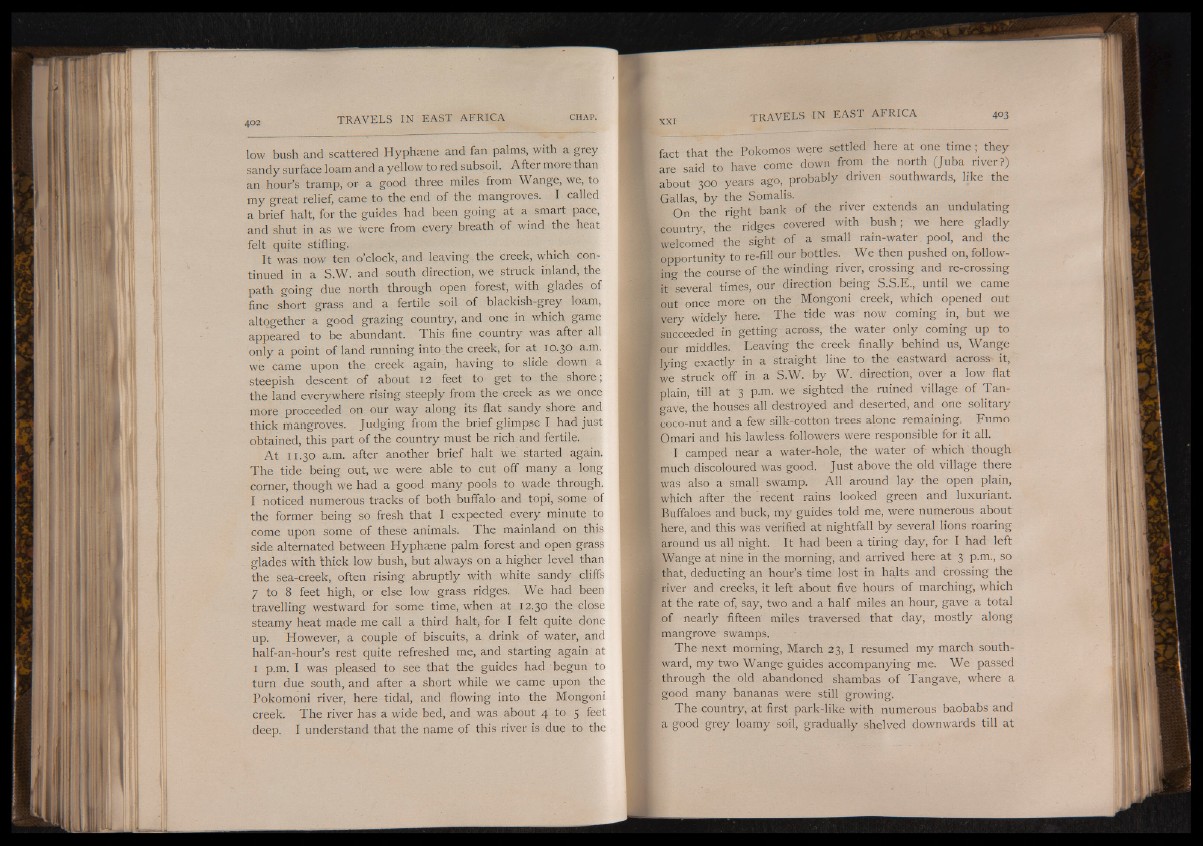
low bush and scattered Hyphaene and fan palms, with a grey
sandy surface loam and a yellow to red subsoil. After more than
an hour’s tramp, or a good three miles from Wange, we, to
my great relief, came to the end of the mangroves. I called
a brief halt, for the guides had been going at a smart pace,
and shut in as we were from every breath of wind the heat
felt quite stifling.
It was now ten o’clock, and leaving the creek, which continued
in a S.W. and south direction, we struck inland, the
path going due north through open forest, with glades of
fine short grass and a fertile soil of blackish-grey loam,
altogether a good grazing country, and one in which game
appeared to be abundant. This fine country was after all
only a point of land running into the creek, for at 10.30 a.m.
we came upon the creek again, having to slide down a
steepish descent of about 12 feet to get to the shore;
the land everywhere rising steeply from the creek as we once
more proceeded on our way along its flat sandy shore and
thick mangroves. Judging from the brief glimpse I had just
obtained, this part of the country must be rich and fertile.
At 11.30 a.m. after another brief halt we. started again.
The tide being out, we were able to cut off many a long
corner, though we had a good many pools to wade through.
I noticed numerous tracks of both buffalo and topi, some of
the former being so fresh that I expected every minute to
come upon some of these animals. The mainland on this
side alternated between Hyphaene palm forest and open grass
glades with thick low bush, but always on a higher level than
the sea-creek, often rising abruptly with white sandy cliffs
7 to 8 feet high, or else low grass ridges. We had been
travelling westward for some time, when at 12.30 the close
steamy heat made me call a third halt, for I felt quite done
up. However, a couple of biscuits, a drink of water, and
half-an-hour’s rest quite refreshed me, and starting again at
1 p.m. I was pleased to see that the guides had begun to
turn due south, and after a short while we came upon the
Pokomoni river, here tidal, and flowing into the Mongoni
creek. The river has a wide bed, and was about 4 to 5 feet
deep. I understand that the name of this river is due to the
fact that the Pokomos were settled here at one time; they
are said to have come down from the north (Juba river?)
about 300 years ago, probably driven southwards, like the
Gallas, by the Somalis. I .
On the right bank of the river extends an undulating
country, the ridges covered with bush; we here gladly
welcomed the sight of a small rain-water pool, and the
opportunity to re-fill our bottles. We then pushed on, following
the course of the winding river, crossing and re-crossing
it several times, our direction being S.S.E., until we came
out once more on the Mongoni creek, which opened out
very widely here. The tide was now coming in, but we
succeeded in getting across, the water only coming up to
our middles. Leaving the creek finally behind us, Wange
lying exactly in a straight line to the eastward across> it,
we struck off in a S.W. by W. direction, over a low flat
plain, till at 3 p.m. we sighted the ruined village of Tan-
gave, the houses all destroyed and deserted, and one solitary
coco-nut and a few silk-cotton trees alone remaining. Fumo
Omari and his lawless- followers were responsible for it all.
I camped near a water-hole, the water of which though
-much discoloured was good. Just above the old village there
was also a small swamp. All around lay the open plain,
which after the recent rains looked green and luxuriant.
Buffaloes and buck, my guides told me, were numerous about
here, and this was verified at nightfall by several lions roaring
around us all night. It had been a tiring day, for I had left
Wange at nine in the morning, and arrived here at 3 p.m., so
that, deducting an hour’s time lost in halts and crossing the
river and creeks, it left about five hours of marching, which
at the rate of, say, two and a half miles an hour, gave a total
of nearly fifteen miles traversed that day, mostly along
mangrove swamps.
The next morning, March 23, I resumed my march southward,
my two Wange guides accompanying me. We passed
through the old abandoned shambas of Tangave, where a
good many bananas were still growing.
The country, at first park-like with numerous baobabs and
a good grey loamy soil, gradually shelved downwards till at